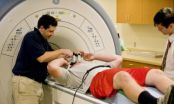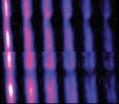(Press-News.org) An approach pioneered by researchers at North Carolina State University gives scientists new insight into the way silicon bonds with other materials at the atomic level. This technique could lead to improved understanding of and control over bond formation at the atomic level, and opportunities for the creation of new devices and more efficient microchips.
Manufacturers build silicon-based devices from layers of different materials. Bonds – the chemical interaction between adjacent atoms – are what give materials their distinctive characteristics. "Essentially, a bond is the glue that holds two atoms together, and it is this glue that determines material properties, like hardness and transparency," says Dr. Kenan Gundogdu, assistant professor of physics at NC State and co-author of the research. "Bonds are formed as materials come together. We have influenced the assembly process of silicon crystals by applying strain during bond formation. Manufacturers know that strain makes a difference in how bonds form, but up to now there hasn't been much understanding of how this works on the atomic level."
Gundogdu, along with Dr. David Aspnes, Distinguished University Professor of Physics, and doctoral candidate Bilal Gokce, used optical spectroscopy along with a method of analysis pioneered by Aspnes and former graduate student Dr. Eric Adles that allowed them to examine what was happening on the atomic scale when strain was applied to a silicon crystal.
"Strain has been used to affect overall chemistry for a long time," Aspnes says. "However, no one has previously observed differences in chemical behavior of individual bonds as a result of applying strain in one direction. Now that we can see what is actually happening, we'll gain a much better understanding of its impact on the atomic scale, and ideally be able to put it to use."
According to Gundogdu, "Application of even small amount of strain in one direction increases the chemical reactivity of bonds in certain direction, which in turn causes structural changes. Up to now, strain has been applied when devices are made. But by looking at the effect on the individual atomic bonds we now know that we can influence chemical reactions in a particular direction, which in principle allows us to be more selective in the manufacturing process."
The research appears online in the Sept. 27 Proceedings of the National Academy of Sciences.
"While we are able to exert some directional control over reaction rates, there remains much that we still don't understand," Aspnes adds. "Continuing research will allow us to identify the relevant hidden variables, and silicon-based devices may become more efficient as a result."
###
The Department of Physics is part of NC State's College of Physical and Mathematical Sciences.
Note to editors: An abstract of paper follows.
"Measurement and control of in-plane surface chemistry during the oxidation of H-terminated (111) Si"
Authors: Bilal Gokce, Eric J Adles, David E. Aspnes, and Kenan Gundogdu, NC State University
Published: Sept. 27, 2010 online in Proceedings of the National Academy of Sciences
Abstract: In-plane directional control of surface chemistry during interface formation can lead to new opportunities regarding device structures and applications. Control of this type requires techniques that can probe and hence provide feedback on the chemical reactivity of bonds not only in specific directions but also in real time. Here, we demonstrate both control and measurement of the oxidation of H-terminated (111) Si. Control is achieved by externally applying uniaxial strain, and measurement by second-harmonic generation (SHG) together with the anisotropic-bond model of nonlinear optics. In this system anisotropy results because bonds in the strain direction oxidize faster than those perpendicular to it, leading in addition to transient structural changes that can also be detected at the bond level by SHG.
END
New Haven, Conn.—A team of Yale University scientists has engineered the cell wall of the Staphylococcus aureus bacteria, tricking it into incorporating foreign small molecules and embedding them within the cell wall.
The finding, described online in the journal ACS Chemical Biology this week, represents the first time scientists have engineered the cell wall of a pathogenic "Gram-positive" bacteria—organisms responsible not only for Staph infections but also pneumonia, strep throat and many others. The discovery could pave the way for new methods of combating the bacteria ...
WEST LAFAYETTE, Ind. - A study by researchers at Purdue University suggests that some high school football players suffer undiagnosed changes in brain function and continue playing even though they are impaired.
"Our key finding is a previously undiscovered category of cognitive impairment," said Thomas Talavage, an expert in functional neuroimaging who is an associate professor of biomedical engineering and electrical and computer engineering and co-director of the Purdue MRI Facility.
The findings represent a dilemma because they suggest athletes may suffer a form ...
(Garrison, NY) The researcher whose revelations about unethical U.S. studies on syphilis in Guatemala in the 1940's led to apologies from the Obama administration last week has written a commentary for Bioethics Forum, the Hastings Center's online publication. She calls for the need to learn from history to better protect human subjects in the developing world.
Susan M. Reverby, a professor at Wellesley College, describes how she unearthed documents about the study by accident while doing research for a book on the Tuskegee syphilis study. The documents, hidden in the ...
Talk about a walk on the wild side: University of Notre Dame researcher Joshua Shrout is co-author of a new paper that shows that bacteria are capable of "standing up" and moving while vertical.
Shrout, assistant professor of civil engineering and geological sciences and a member of the Eck Institute for Global Health, has been studying the surface motility of bacteria since 2004. In 2008, UCLA researcher Gerard Wong suggested that an undergraduate bioengineering senior design group that he was advising track the bacterium Shrout was studying. After some interesting patterns ...
"Better and faster results!" is the clarion call for scientists and engineers to continually strive to improve their research tools. Of the tools used to study material structures at the atomic and molecular scales, there is none finer than Nuclear Magnetic Resonance (NMR) spectroscopy and its daughter technology Magnetic Resonance Imaging (MRI). Now, the latest development from the research group of one of the word's foremost authorities on NMR/MRI technology promises NMR/MRI results that are better and faster than ever before – a million times faster!
Through a combination ...
In a study that sheds new light on the causes of Parkinson's disease, researchers report that brain cells in Parkinson's patients abandon their energy-producing machinery, the mitochondria. A shutdown in fuel can have devastating effects on brain cells, which consume roughly 20 percent of the body's energy despite making up only 2 percent of body weight.
The findings indicate that boosting the mitochondria with FDA approved drugs early on may prevent or delay the onset of Parkinson's. The study will be published in the one-year anniversary issue of the journal Science ...
DURHAM, N.C. -- The cost of obesity among U.S. full-time employees is estimated to be $73.1 billion, according to a new study by a Duke University obesity researcher, published today in the Journal of Occupational and Environmental Medicine.
This is the first study to quantify the total value of lost job productivity as a result of health problems, which it finds is more costly than medical expenditures.
Led by Eric Finkelstein, deputy director for health services and systems research at Duke-National University of Singapore, the study quantified the per capita cost ...
The "turtle and dugong capital of the world", the northern Great Barrier Reef (GBR) and Torres Strait region, faces increased pressure under climate change from human actions such as fishing, hunting, onshore development and pollution.
"Depletion of turtle and dugong numbers increases their vulnerability to other threats and lowers their ability to cope with climate change," Dr Mariana Fuentes of the ARC Centre of Excellence for Coral Reef Studies and James Cook University will tell the Coral Reef Symposium in Canberra today.
Dr Fuentes says that turtles in particular ...
New York, NY, October 8, 2010—Young adults continue to represent one of the largest groups of Americans without health insurance, with nearly 15 million people aged 19-29 uninsured in 2009—an increase of more than 1 million over 2008, according to a Commonwealth Fund report released today. However, the Affordable Care Act (ACA) is poised to make a significant difference for this population, as up to 12.1 million could gain subsidized insurance once all of the law's provisions go into effect in 2014.
The report, Realizing Health Reform's Potential: Young Adults and the ...
Austin-Lehman Adventures, Travel + Leisure's "World's Best" Operator Responds to Client Dream List Wishes - Breaks New Ground in Luxury Multisport Adventure to Israel and Morocco
The active travel company that set the adventure tour standard in Yellowstone National Park and then took their winning formula to Europe, Africa and beyond just released its 2011 catalog that includes two new groundbreaking tours in Israel and Morocco. Clients of Austin-Lehman Adventures have been asking for these "dream" destinations for years and the tour company responded with Israel & Jordan ...

